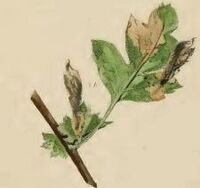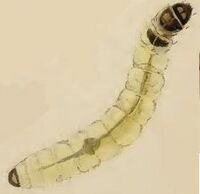Biology:Coleophora siccifolia
| Coleophora siccifolia | |
|---|---|

| |
| Scientific classification | |
| Domain: | Eukaryota |
| Kingdom: | Animalia |
| Phylum: | Arthropoda |
| Class: | Insecta |
| Order: | Lepidoptera |
| Family: | Coleophoridae |
| Genus: | Coleophora |
| Species: | C. siccifolia
|
| Binomial name | |
| Coleophora siccifolia Stainton, 1856[1]
| |
Coleophora siccifolia is a moth of the family Coleophoridae. It is found in most of Europe.
The wingspan is 10–12 mm (0.39–0.47 in).[2] Coleophora species have narrow blunt to pointed forewings and a weakly defined tornus. The hindwings are narrow-elongate and very long-fringed. The upper surfaces have neither a discal spot nor transverse lines. Each abdomen segment of the abdomen has paired patches of tiny spines which show through the scales. The resting position is horizontal with the front end raised and the cilia give the hind tip a frayed and upturned look if the wings are rolled around the body. C. siccifolia characteristics include head light greyish-ochreous. Antennae white, ringed with fuscous, basal joint pale greyish-ochreous. Posterior tarsi grey-whitish. Forewings brownish-grey, somewhat shining. Hindwings rather dark grey.[3]
The larvae feed on Alnus, Betula lutea, Betula pubescens, Carpinus betulus, Crataegus laevigata, Malus domestica, Sorbus aucuparia and Tilia species. They create a tubular leaf case. It is almost barrel-shaped, with a large leaf fragment that, while withering, folds itself around the tube. Before a larva leaves a mine to start a new one, it often detaches the upper epidermis by cutting along the sides of the mine. The detached epidermis either falls off or dries and curls.[4] Full-grown larvae can be found in August in Great Britain and in October in continental Europe.
References
- ↑ "Fauna Europaea". http://www.faunaeur.org/full_results.php?id=435634.
- ↑ "microlepidoptera.nl". http://www.microlepidoptera.nl/soorten/species.php?speciescode=260130&p=1.
- ↑ Meyrick, E., 1895 A Handbook of British Lepidoptera MacMillan, London pdf
 This article incorporates text from this source, which is in the public domain. Keys and description
This article incorporates text from this source, which is in the public domain. Keys and description
- ↑ Ellis, W N. "Coleophora siccifolia Stainton, 1856 grey birch case-bearer". https://bladmineerders.nl/parasites/animalia/arthropoda/insecta/lepidoptera/ditrysia/gelechioidea/coleophoridae/coleophora/coleophora-siccifolia/. Retrieved 8 October 2019.
External links
Wikidata ☰ Q5144310 entry
 |



